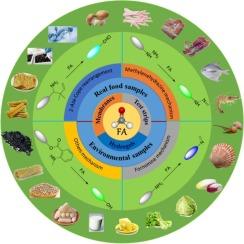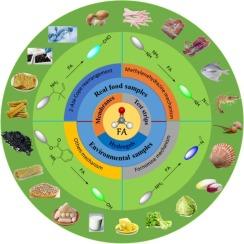环境和食品样品中甲醛小分子荧光探针检测研究进展综述
IF 9.8
1区 农林科学
Q1 CHEMISTRY, APPLIED
引用次数: 0
摘要
甲醛是一种具有致癌性和诱变性的有害物质,为保护公众健康和环境,需要灵敏、准确的检测方法。虽然许多评论已经探讨了FA荧光探针,但目前的文献主要强调生物系统,在解决FA在环境监测和食品安全中的作用方面留下了空白。本文综述了FA检测的识别机制,包括2-aza-Cope重排、亚甲肼反应、甲亚胺生成等机制。此外,本综述强调了这些探针在现实世界中的实际应用,即将其纳入试纸、水凝胶和膜中,用于环境监测和食品安全。此外,本文还强调了将荧光探针与数据处理算法和人工智能技术相结合的智能检测系统的未来发展方向。通过对该领域现有知识的综合,本文旨在促进FA检测技术的未来研究和进步,最终为改善环境管理和公共健康保护做出贡献。本文章由计算机程序翻译,如有差异,请以英文原文为准。


Advancements in small molecule fluorescent probes for the detection of formaldehyde in environmental and food samples: A comprehensive review
Formaldehyde (FA), a hazardous substance with carcinogenicity and mutagenicity, necessitates sensitive and accurate detection methods for protecting public health and the environment. While numerous reviews have explored FA fluorescent probes, the current literature predominantly emphasizes biological systems, leaving a gap in addressing FA’s roles in environmental monitoring and food safety. This review discusses recognition mechanisms for FA detection, including 2-aza-Cope rearrangement, methylenehydrazine reaction, formimine formation, and other mechanisms. Furthermore, this review underscores the practical applications of these probes in real-world contexts, namely their incorporation into test strips, hydrogels, and membranes for environmental monitoring and food safety. Moreover, this review highlights future directions for developing intelligent detection systems that combine fluorescent probes with data processing algorithms and artificial intelligence technologies. By synthesizing the current knowledge in this area, this review aims to stimulate future research and advancements in FA detection technology, ultimately contributing to improved environmental management and public health protection.
求助全文
通过发布文献求助,成功后即可免费获取论文全文。
去求助
来源期刊

Food Chemistry
工程技术-食品科技
CiteScore
16.30
自引率
10.20%
发文量
3130
审稿时长
122 days
期刊介绍:
Food Chemistry publishes original research papers dealing with the advancement of the chemistry and biochemistry of foods or the analytical methods/ approach used. All papers should focus on the novelty of the research carried out.
 求助内容:
求助内容: 应助结果提醒方式:
应助结果提醒方式:


